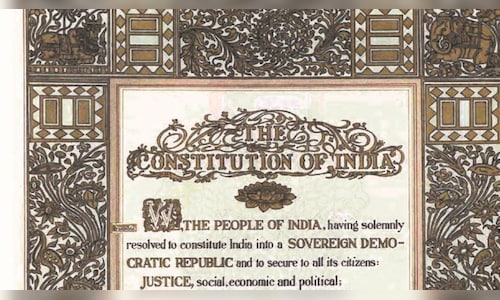
Crafted by the Constituent Assembly under the leadership of Dr B.R. Ambedkar, the Indian Constitution laid the foundation for a democratic republic in the newly independent nation. The original document consisted of 395 articles, 22 parts, and 8 schedules. It was formally adopted on November 26, 1949, and came into effect on January 26, 1950. Since then, the Constitution has been amended 104 times, expanding to 448 articles, 25 parts, and 12 schedules.
Also Read: President releases coin, stamp to honour 75 years of India’s Constitution
The Indian Constitution is more than just a legal framework — it serves as the cornerstone of India’s democratic republic. It is one of the longest and most detailed constitutions in the world. It offers a vision of a society where the rights and freedoms of every citizen are safeguarded. It defines the rights and duties of citizens, outlines the structure and functions of government institutions, and establishes the principles of governance for the country.
With its detailed provisions, evolving amendments, and far-reaching impact on governance, the Indian Constitution stands as a living document that shapes the very essence of India’s democratic identity.
Beyond its legal framework, the Constitution embodies fundamental values of justice, liberty, equality, and fraternity — the core principles that uphold the democratic fabric of India. These values ensure that every citizen is treated with dignity, respect, and equality before the law.
But how well do we really know the process behind the formation of the Constitution that governs the world’s largest democracy? Take this quiz to find out.
1) Who is considered the chief architect of the Indian Constitution?
a) Sardar Vallabhbhai Patel
b) Jawaharlal Nehru
c) Dr B.R. Ambedkar
d) Maulana Abul Kalam Azad
2) When was the Constituent Assembly of India formed?
a) 1946
b) 1947
c) 1949
d) 1950
3) Which document served as the inspiration for the Indian Constitution?
a) British Constitution
b) US Constitution
c) Government of India Act, 1935
d) All of the above
4) How long did the Constituent Assembly take to draft the Indian Constitution?
a) 2 years
b) 2 years, 11 months, and 18 days
c) 3 years, 18 days
d) 4 years, 10 months and 10 days
5) How many women participated in the debates during the Constituent Assembly’s deliberations?
a) 5
b) 10
c) 15
d) 20
6) Which city was the location of the first meeting of the Constituent Assembly?
a) New Delhi
b) Calcutta
c) Lahore
d) Mumbai
7) How many members of the Constituent Assembly signed the final draft of the Constitution?
a) 100
b) 284
c) 389
d) 450
8) Who was the president of the Constituent Assembly?
a) Dr B.R. Ambedkar
b) Jawaharlal Nehru
c) Dr Rajendra Prasad
d) Maulana Abul Kalam Azad
9) Who was the primary calligrapher who hand-wrote the original copy of the Indian Constitution?
a) Prem Behari Narain Raizada
b) Beohar Rammanohar Sinha
c) Nandalal Bose
d) M.A. Ansari
10) How many times has the Indian Constitution been amended as of now?
a) 100
b) 105
c) 106
d) 110
11) Who has the power to amend the Indian Constitution?
a) The President of India
b) The Supreme Court of India
c) The Parliament of India
d) The Prime Minister of India
12) Which part of the Indian Constitution contains provisions related to the Fundamental Rights of citizens?
a) Part I
b) Part II
c) Part III
d) Part IV
13) Who was appointed as the constitutional adviser to the Constituent Assembly in 1946?
a) Jawaharlal Nehru
b) Sardar Vallabhbhai Patel
c) Mahatma Gandhi
d) B.N. Rau
14) Who presented the ‘Objective Resolution,’ which later became the Preamble of the Indian Constitution, and when?
a) Dr B.R. Ambedkar, August 15, 1947
b) Jawaharlal Nehru, December 13, 1946
c) Sardar Vallabhbhai Patel, August 15, 1947
d) Maulana Abul Kalam Azad, December 13, 1946
15) What was the total expenditure incurred for the formation of the Indian Constitution?
a) ₹50 lakh
b) ₹64 lakh
c) ₹75 lakh
d) ₹100 lakh
Answers: 1-c, 2-a, 3-d, 4-b, 5-b, 6-a, 7-b, 8-c, 9-a, 10-c, 11-c, 12-c, 13-d, 14-b, 15-b.



